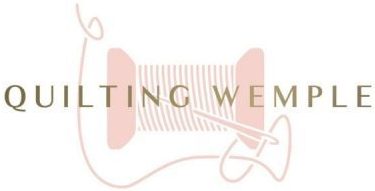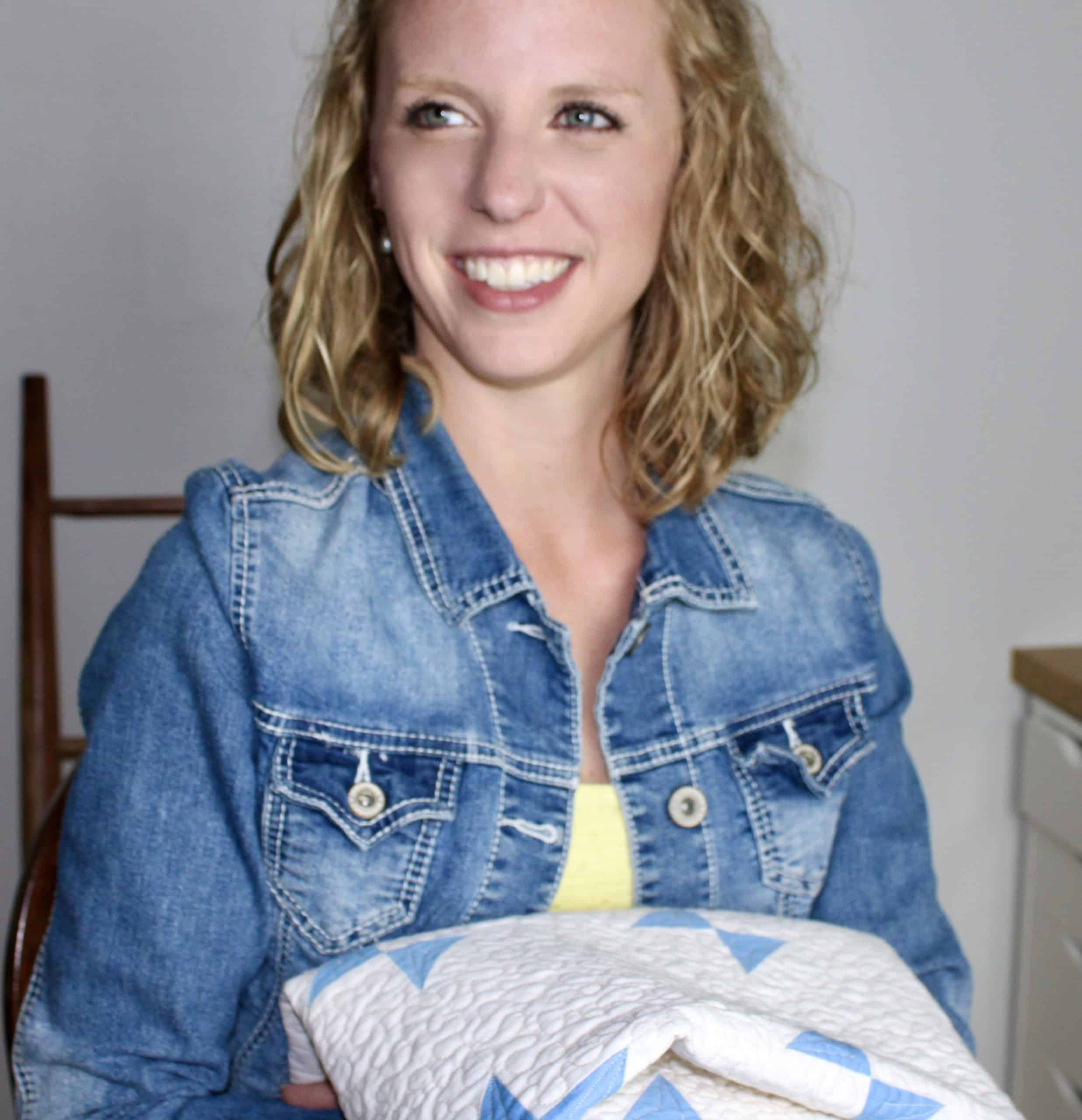I remember when I first started quilting, I thought feathers were an outdated quilting design that made your quilt look old-fashioned.
Fast-forward i-dont-know-how-many-years and now I’m making googalee eyes at the most gorgeous modern feathers I’ve ever seen and it’s all I can do to figure out how to incorporate them.
Feathers with personality, some with added swirls, some with more fern like shapes, I’m blown away by the versatility in this design and how drastically it can be adjust based on your personal preferences.
So I went on a mission. Quilting feathers in different shapes, contexts, and in unexpected ways to keep this traditional quilting design youthful and more importantly useful, no matter what quilt you’re working on.

What is feather quilting
Feather quilting is a free motion quilting design that stacks a flower petal shape on top of itself over and over again giving the illusion of a feather!
This design is fun as it is more of a category of quilting designs as opposed to a hard and fast design that can only be made one way.
You can make it more curvy and dramatic, or keep it traditional with a straight or slight wave.
Feather quilting has traditionally been more of a “featured motif” kind of design where the feather draws attention to that area of the quilt, however with the ever evolving modern quilting, anything goes.
You’ll see quilters quilting feathers in different shapes and patches as well as making it look like the feather is passing behind certain patches of your quilt top.
With so many fun ways to utilize this quilting design, learning how to quilt them will quickly become one of your go-to designs when you are working on something that calls for the extra effort.
How do you free motion quilt a feather
There are two ways to attack the free motion feather, bottom up, and top down.
After practicing both types, you may find you prefer one more than the other, or you may find it beneficial to learn both for when situations call for different techniques.
Top Down – Using a Spine
Start by drawing or quilting a curvy line across the area you’d like to fill in. The curvier it is, the more whimsical it’ll feel.
When you get to the top of the section you are working on, make a loop. This is the top plume to your feather.
Now all you have to do is make half heart designs all the way back down the spine of the feather doing both sides as you go.
Bottom up – Without a spine
For this one, we simply start building those half heart designs in the opposite direction stacking on top of each other as we go.
If the ambiguity of where the feather will go or how its going to look bothers you, feel free to use a marking tool to mark in a spine that you can roughly follow as you go.
For a more in depth tutorial on how to quilt feathers, definitely check out this tutorial by XXX.
Things to consider when crafting your feather
There are a few things you can play with to make a feather your own so consider these couple things when going to craft your feathers:
Petal Shapes – Do you want more of a rounded feather petal or a sharper fern like shape?
Area Size – do you need or want to echo inside your petals for denser stitching requirements?
Curviness – Maybe a curlier feather is just more “you” no matter what the quilt looks like. Or maybe you like the clean look of a traditional straight feather.
Corners of the quilting area – no matter what your feather looks like, those petals need to fill in as much of the area as possible – especially into the corners of the shape. Otherwise you might have to go back and add a filler design.
Knowing where you plan to use your feathers and how they fit into the greater quilting plan will make a world of difference in getting your feathers just the way you like them, the first time.
Ideas for Quilting Feathers in Different Shapes
So how do we start incorporating this fun design? I’ve searched across the internet for inspiration on how to use this design in different situations to give you a jump start in your quilting plan.
How to quilt a feather in a square

Around the Edges – Using the edges of the square as your spine, quilt half a feather all the way around the inside of the square.
Diagonally – Starting with a spine the curves through the middle of the square on the diagonal, build your petals backwards taking care to make the petals larger through the middle so they reach into the corners as you go.
Making Mini Triangles – Make two feathers! Pretend a line runs down the center of the square and build two feathers that originate from opposing corners for a cool fan look.
How to quilt a feather in a triangle

Radiating from the center – Who ever said you needed a spine? Make a teardrop shape going toward the top of the triangle and continue making petals all the way around that point until you reach the beginning again!
Using the edge as a spine – Similar to the square, only this time you are only doing a single edge, not following all the way around all three edges.
Curving through the triangle – you can get some fun designs with different triangles, try auditioning different spine shapes to see what you like best.
How to quilt feathers in irregular shapes

To quilt feathers in irregular shapes, you can use the same ideas as the triangles:
Radiate from the center, using an edge as a spine, or curving through the shape and filling in.
The only catch to making feathers look natural in an irregular shape, is making sure you make petals large enough that they reach from edge to edge filling in as much of the shape as possible.
You want the petals closest to the corner to make it as far into the corner as possible leaving as little negative space as possible.
I’vee included examples of a couple irregular spaces above, but the same principle can be used for any shape you come across.
How to quilt feathers in circles

A single continuous circle – this one is best completed by starting out with a marked circle guide. Use a plate and a marking tool to use as your invisible spine to build off of. Work your way around the circle until you’ve reached your starting point. Be sure to try and gauge the last few petals so they are spaced evenly and you don’t end up with a really large or really small last petal.
Following the outside of the circle as your spine – This one is similar to the first one except you’ll have an actual circle stitched, whether its a circle in your piecing or something you stitched specifically. Use it as your spine only stitching the outside of the circle to get a flower petal effect.
Spiraling in – This one is super fun and now that I’ve found I can’t wait to give it a try on my next quilt. Mark a spine that spirals in on itself. Create your petals as you work your way out. You may need to stitch petals on both sides for the outer layers of the spiral and switch to only a single side as you work your way in.
Feather Meanders

With a swirl and echo – It wouldn’t be a feather inspiration post without the famous feather meander, one of Angela Walters go-to designs. This meander starts with a swirl that uses a feather echo along the outside of the swirl instead of swirl echos. Its a fun whimsical and feminine design that will make almost all quilters smile and gets a ton of feather practice in at the same time!
Tips for quilting feathers on a domestic sewing machine
The biggest tip I have for quilting feathers on your home sewing machine is to not bite off more than your sewing machine can chew.
Trying to manage a single huge feather across the entire quilt on a sewing machine with a 4” throat is a recipe for frustration and mistakes.
Now if you broke that feather up into offshoots and built it up one offshoot at a time, you are able to localize your quilting to a smaller area that is much easier for you to navigate around without constantly wrestling with the bulk of the quilt.
The same goes for side to side.
If you can’t reasonably quilt a single petal in one motion because you planned a feather too large, your feather is likely going to end up with kinks in it where you had to stop and reposition your hands to finish the motion.
Stay with a scale that you can realistically manage in your smaller sewing machine and with a little practice you’ll be nailing those feathers in no time.
Feather Quilting Tools and Notions
Looking for a little extra help?
There are quilting rulers for that!
The one downside to quilting rulers for feathers is that your only option is a feather with perfectly consistent petal sizes and shapes the full length of the feather.
A very traditional look and great for some, but not my personal cup of tea.
I personally prefer the look of varying petal sizes as I think it gives the feather a more modern look with a bit of personality so I have not tried these types of rulers specifically to be able to vouch for how well they work.
So while I can’t necessarily say whether they are worth the money or not, if you like a bit more structure to your feathers, be sure to check out your ruler options and see if anything jumps out at you!
If you have tried them be sure to add your thoughts to the comments at the end of the post!
So now that I feel like the character from Forrest Gump talking about all the ways to cook shrimp, I hope I’ve given you a fresh dose of inspiration to try quilting feathers in different shapes.
And if you liked all these ideas, be sure to sign up for my email list at the very top of this page and you’ll get updates anytime new articles come out.









0 Comments